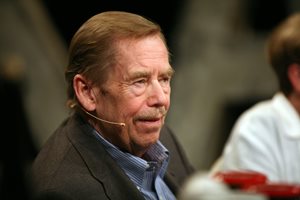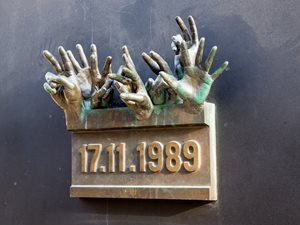Thirty years ago, the Czechs decided that they no longer wanted to live in a country with a communist regime. They wanted freedom and democracy. There were several major figures in the Velvet Revolution that took place in November 1989. However, Václav Havel, the Czechoslovak and Czech President, left the most distinctive impression on people throughout the world. He was a playwright, an author, a stage technician, and also a political prisoner in spring 1989. The events of November 1989 took him all the way to Prague Castle, the seat of Czech presidents, where he stayed until 2003.
The last Czechoslovak and first Czech president
 Václav Havel was born to a prominent entrepreneurial and intellectual family in October 1936 that owned several properties in Prague, including Lucerna Palace, completed shortly after WWI, near St. Wenceslas Square. Today, you can visit a late art nouveau café, the oldest operating cinema in Prague with rich stucco decorations, or see a concert in Lucerna. The popular sculpture by David Černý called The Horse is also in Lucerna. The sculptor wittily parodies the symbol of Czech lands: the statue of St. Wenceslas. The Lucerna roof is also exceptionally open to the public, not only offering unique views of Prague Castle, but also of the newly reconstructed National Museum.
Václav Havel was born to a prominent entrepreneurial and intellectual family in October 1936 that owned several properties in Prague, including Lucerna Palace, completed shortly after WWI, near St. Wenceslas Square. Today, you can visit a late art nouveau café, the oldest operating cinema in Prague with rich stucco decorations, or see a concert in Lucerna. The popular sculpture by David Černý called The Horse is also in Lucerna. The sculptor wittily parodies the symbol of Czech lands: the statue of St. Wenceslas. The Lucerna roof is also exceptionally open to the public, not only offering unique views of Prague Castle, but also of the newly reconstructed National Museum.When WWII ended, Havel attended the elite boarding school in Poděbrady. He never finished his university studies and finally discovered the environment he fell in love with in 1959. He started working in Prague theatres.
Havel, the theatre enthusiast
His work in the Na Zábradlí Theatre near Charles Bridge was most distinctive. Even though Havel started as a stage technician, he soon became a playwright, and later an assistant director. In 1963, the Na Zábradlí Theatre featured his own play The Garden Party. The Theatre continues to feature Havel’s plays, even with English subtitles, and their production about the life of the former President, Velvet Havel, has received several awards. If you go to the theatre, do not miss the nearby Slavia café, which became the centre for people who were unhappy about the communist regime in the second half of the 20th century, Václav Havel included.Life before the fall of the Communist regime
In 1968, Czechoslovakia was invaded by the Soviet Army, which ended the gradual revival of a regime that started to open up to the outside world. Censorship was reintroduced and thousands of people decided to emigrate to the democratic West. Václav Havel started to bring attention to the violation of human rights in Czechoslovakia and the political prisoners, for which Havel was sentenced to four and a half years in prison. He served a part of his sentence in prisons in Prague and Plzen.The more Havel was banned in Czechoslovakia, the more his plays were produced abroad. In the 1980s, Václav Havel lived at Rašínovo nábřeží in Prague, right next to the iconic Dancing House. The idea to build something on the empty lot, created during WWII, came out of a meeting between Havel and architect Vlado Milunić. The project of Ginger and Fred, what the dancing house is called, started in the 1990s, and it was carried out by renowned architect Frank O. Gehry.
Revolution and presidency
 On 17 November 1989, the regime of the Communist Party took harsh action against a student demonstration at Národní třída. The event is commemorated by a plaque called The Hands, installed on the wall of the palace in Národní třída. The revolution led to the transfer of power and the first free elections where people could choose from several political parties. Václav Havel became the new President and he stayed in this office for thirteen years.
On 17 November 1989, the regime of the Communist Party took harsh action against a student demonstration at Národní třída. The event is commemorated by a plaque called The Hands, installed on the wall of the palace in Národní třída. The revolution led to the transfer of power and the first free elections where people could choose from several political parties. Václav Havel became the new President and he stayed in this office for thirteen years.He oversaw the opening of the area of Prague Castle to visitors, the restoration of its gardens and the Deer Moat. Thanks to that we can admire one of the largest castle compounds in the world today. Near Prague, in Central Bohemia, he opened the chateau gardens to the public at the summer presidential home of Lány Chateau. In 2003, his last presidential mandate permitted by the Constitution ended. He passed away at the age of 75 in 2011. Today, the Prague Airport and the square by the National Theatre hour him by carrying his name.






-(1).jpg?width=1920&height=1204&ext=.jpg)




